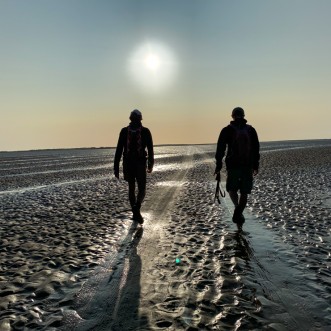Here’s an article I wrote for the Telegraph online about the Islandering book.
Dolphins, secret coves and military ruins: 10 big adventures on Britain’s tiniest islands
Lisa Drewe, author of Islandeering, shares her top 10 islandeering adventures in Britain.
Does it sometimes feel difficult to find routes off the beaten track, to feel real freedom and explore uncharted quarters? Fear not, you don’t have to travel to the four corners of the globe to find these undiscovered places. They exist right here in Britain – in 4000 places or more.
These are our islands and their unique outer edges, the boundary between land and sea and the greatest wildness left in Britain. They are the ultimate places for adventure, challenge and solitude. The best way of experiencing them is islandeering – walking, scrambling, wading and even swimming around an island’s rim. With dramatic clifftops, wild beaches, tiny tracks, rocky scrambles and deep gullies there is always a route to be found.
From urban islets to clifftop nature reserves, secretive military islands to remote beach idylls there are secluded swims, seashore foraging, incredible wildlife, stunning seascapes, abandoned villages and vibrant communities to discover. Getting to them can be an adventure though with exhilarating RIB rides, exposed cliff scrambles and epic tidal crossings, one of which is known as Britain’s ‘deadliest highway’. Here are some favourite islandeering adventures.
- Scolt Head, Norfolk
A wet and wild wade through sun-warmed channels and walk along a stunning natural beach. From Burnham Overy Staithe cross two creeks to get to the island, then wade along the tidal creeks and wildlife-filled saltmarsh of the south shore, enjoying warm, secluded swims on the way. Cross to the north coast with its pounding surf and wild and extensive sands and return in true islandeering style – let the incoming tide float you gently back.
- Steepholm, Somerset
The exhilarating RIB ride from Weston-Super-Mare is part of this island’s adventure. Once there, this is an easy clifftop amble around a small former military outpost-turned-nature reserve. Those with a head for heights can test their nerve on steep exposed sections to explore military ruins. If that makes you dizzy you can search for the ghoulish egg sacks of the Culvert spider in the underground munition stores or enjoy spectacular views across the Bristol Channel.
- Foulness, Essex
Essex’s best kept secret. Step out on to Maplin Sands to follow the legendary Broomway. With an incoming tide that is faster than most people can run and MoD owners who like to fire missiles out across the sands this walk does require some planning. The reward for the few who attempt it though is a fabulous wilderness experience and the chance to chat to friendly islanders with their unique language and tales of ‘stringies’, ‘cadgers’ and ‘doggies’.
- Chapel, Cumbria
An exhilarating tidal route, with notorious sinking sands and extremely quick tides. A Queen’s Guide to the Sands will know the safest route across the fast-flowing River Leven and the wilderness of Morecombe Bay. The circumnavigation then follows on the glorious sands of the island’s foreshore against the backdrop of the mountains of the South Lakes. The guide’s advice – ‘if you feel yourself sinking, don’t stop just keep moving’.
- Thorney, Sussex
Escape the jostle of the south coast and access a remotely controlled MoD gate for a wild walk around the outer edge of this secretive military island. Here the coast is alive with the sounds of the creeping tides and the calls of oystercatchers and full of the earthy aromas of seaweed and salty mudflats drying in the sun. Enjoy fabulous views of the expanse of Chichester harbor, explore atmospheric St Nicholas Church and swim from the wild sandy beach at the southern tip.
- Hilbre, Wirral
The thrill of crossing the vast sands of Liverpool Bay is only heightened by knowing the tide is creeping invisibly towards you. The first of the three islets of this mini-archipelago, Little Eye, feels like a miniature Robinson Crusoe island topped by ferns and wildflowers. Cross Middle Eye to reach Hilbre with its sculpted, deep red sandstone cliffs, bird observatory and the ruins of an old lifeboat station. Find a large cave, stacks, wave-cut platforms and small beaches around its foreshore.
- Ynys Giftan, North Wales
Float on your back in one of the deliciously warm pools that grace this round-island route. Absorb the views of the mountains of Snowdonia and the fairy tale turrets of Portmeirion. Let the birdsong from the tangle of trees and bushes of this uninhabited island soothe you. The crossing of wild saltmarsh teeming with wildflowers, seasonal wildfowl, egrets and herons and the shimmering tidal sands only heightens its sense of place. This is one for chilling out.
- Ynys Lochtyn, West Wales
A rocky adventure to see Europe’s largest pod of bottlenose dolphins. Step off the Ceridigion Coast Path and scramble down the colourful and vertiginous cliffs on a climbers path to the rocks below. The route then continues through a sea cave, onto a large ledge, then up a grassy path onto the island itself. From this vantage point you can enjoy views of the whole sweep of Cardigan Bay and the special marine creatures that live within it.
- Vallay, Outer Hebrides
Rounding the western tip nothing can quite prepare you for the staggering beauty of the north coast and the breath-taking views to the St Kilda archipelago – the remotest part of Britain, sixty or so kilometres away. The route starts with an epic 2 km crossing of tidal Vallay Strand to reach paths through the flower-studded machair and the dramatic undulations of the dunes that back incredible white beaches. Great for a spectacular night under the stars.
- Eileen Shona, West Coast Scotland
Fairytale forests, an enchanting valley, and secret coves await once you have negotiated a short tidal crossing and discovered the ancient, hidden path to this magical island. The route is an islandeering dream with plenty of stops for secluded swims, foraging for giant mussels and clams and discovering the ancient woods around the main house. You can do this in a day but its charming holiday cottages are a haven – no wonder the author of Peter Pan chose it for his summer retreat.


